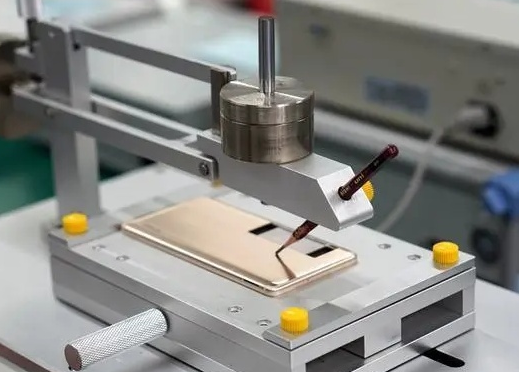
Rockwell hardness (HR)
A diamond cone (HRC) or hardened (tungsten) steel ball indenter (HRB, etc.) is used to press into the surface of the tested material with a preload of 10 KGF and a main test force of 60, 100, or 150 KGF.
Surface Rockwell hardness (HR)
According to the set scale, a diamond cone or hardened (tungsten) steel ball indenter is used to press into the surface of the tested material. Surface Rockwell measurement is used in relatively fragile and thin materials because of its small force and shallow indentation.
The preload is 3 KGF, and the main test force is 15, 30, or 45 KGF.
Vickers hardness (HV)
A square cone diamond indenter with a relative angle of 136 ° was pressed into the surface of the tested material with a test force of 1-120 KGF.
The indentation is observed and measured by microscope or USB camera.
Micro Vickers hardness (HV)
Usually, the square cone diamond indenter with a relative angle of 136 ° is pressed into the surface of the tested material with a test force of no more than 1kgf.
The indentation is observed and measured by a precision microscope or a high-resolution USB camera.
600X magnification is the most common, and 1000x magnification is more and more widely used.
Knoop hardness (HK)
Usually, the slender diamond vertebral body is pressed into the surface of the tested material with a test force of no more than 1 KGF.
The indentation is observed and measured by a precision microscope or a high-resolution USB camera.
A magnification of 600X is the most common.
Brinell hardness (HB)
Cemented carbide balls or carbon steel balls with diameters of 1, 2.5, 5 or 10 mm were pressed into the surface of the tested material with a test force of 1-3000 KGF.
Relatively large indentation is observed and measured by microscope or USB camera.
Leeb hardness (HL) (rebound mode)
Portable hardness test. It uses a certain mass of impact body with tungsten carbide ball head to impact the specimen surface under the action of certain spring elasticity. This impact force makes the surface of the tested material produce plastic deformation, forming an indentation, and then the impact body loses its original speed (or energy).
Therefore, the softer the tested material is, the more velocity the impactor loses in the rebound process. Leeb hardness can be applied to a variety of parts, and there are few test requirements to be observed.
Ultrasonic hardness test (UCI)
Portable hardness test. A Vickers shaped diamond indenter is fixed on a vibrating rod and applied to the surface of the tested material with a certain force value. Then, according to the ultrasonic vibration, its damping effect is analyzed, so as to measure the hardness of the material.
Ultrasonic hardness test is usually used for small, thin parts which cannot be tested by rebound hardness tester.
Shore hardness (short)
Portable (rubber / plastic products) hardness test. Shore hardness is a steel pressure needle with a certain shape, which is pressed into the surface of the sample vertically under the action of the test force. When the surface of the presser foot completely fits with the surface of the sample, the end face of the pressure needle has a certain extension length (i.e. the depth of the pressure needle penetrating into the measured object) relative to the pressure foot plane, and the value of this length is used to represent the size of shore hardness.
The indenter is connected to a linear measuring device, and the measured indentation depth value is then converted to shore hardness value by mechanical or electronic system. The deeper the indentation, the softer the material.
IRHD (international rubber hardness)
According to the depth of the ball indenter pressing into the material to be measured, the performance of the elastic material or rubber against the indenter is measured. Apply an initial contact force to the 1, 2.5 or 5mm ball indenter and set the indentation depth to zero. Then increase the force value to the specified total load, and then measure the depth of material pressing. The IRHD value is related to the depth of the indenter. This measurement method is usually used to test smaller parts and O-rings.
Vickers hardness
Portable hardness test.
Place the measured material between the table and the penetrator. Then apply force to the handle until you feel it has touched the bottom, and then the dial indicator will read. There are different types of indenters for Vickers hardness, and different force values are set for different materials.
Uncommon hardness scale
The following hardness testing methods are not commonly used or have been replaced by other methods:
HM Martens hardness (indentation tester, previously expressed as Hu - universal hardness)
H ball indentation hardness
HVT improved Vickers hardness test method, depth measurement
HBT improved Brinell hardness test method, depth measurement
Barcol (Barker) - Indentation Hardness
